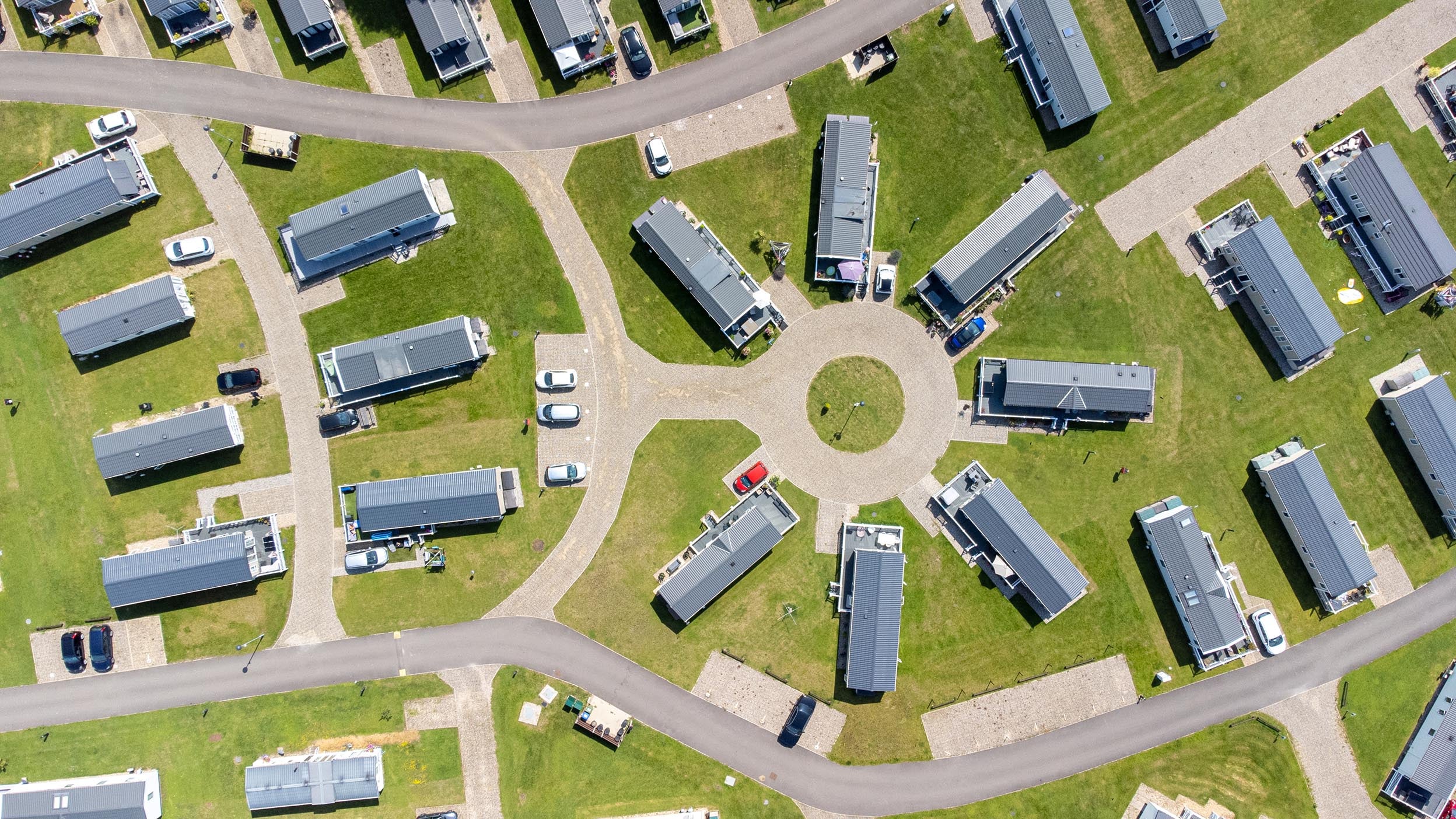
Real Estate
Real estate pricing: Short-term view needs long-term perspective
To determine what current pricing, expected fundamentals, and capital spending mean for future returns, the long view on real estate cap rates provides perspective.

We believe lower interest rates should help lower real estate debt costs and may start a chain reaction for a recovery in prices.
Lower interest rates may help, in turn, reduce cap rates, which should drive higher real estate prices.
We think improved tenant confidence and a sharp reduction in new supply may potentially drive rent growth starting next year.
While 2023 was challenging for US commercial real estate (CRE) investors, we believe that it’s “off the floor in 2024,” with real estate poised to start its price recovery sometime in the second half of the year. Think of it as a chain reaction, which starts with fed fund rate reductions. That we believe should help to lower real estate debt costs, which should, in turn, reduce upward pressure on cap rates. An eventual lift in cap rates should drive higher real estate prices.
The December 2023 Federal Open Market Committee (FOMC) meeting sent the message that real estate investors have been waiting for. Confidence in lower inflation is solidifying, and monetary tightening is nearing an end. The fed funds rate is expected to be cut three times in 2024 and several more times into 2027. While inflation and economic growth have surprised to the upside since then, at the March 20 meeting the FOMC reinforced that they expect to start reducing the fed funds rate sometime this year with additional cuts to follow.
Lower policy rates are a necessary catalyst for reducing interest rates more broadly, including CRE debt costs. The historical relationship between policy rates and debt costs has been well established. Real estate debt costs are priced at a spread above certain base interest rates, including the fed funds rate. The spread varies over time. When policy rates are escalated, the spread to real estate debt costs narrows, which eventually causes real estate debt costs to rise in order to maintain a premium over base policy rates. By contrast, when policy rates are reduced, so is pressure on debt costs, eventually leaving room for them to fall, which ultimately affects real estate cap rates.
Reductions in real estate debt costs have historically led to lower cap rates and price growth. Because commercial real estate investing often includes financing, real estate debt costs historically have been closely related to real estate cap rates (the relationship between a property’s net operating income divided by the property’s purchase price). Since the start of 2000, the correlation between market cap rates2 and fixed debt costs3 has been a very strong 0.85.4 A decline in debt costs is highly likely to result in a decline in cap rates, which typically reflects rising prices.
The historical relationship between year-over-year changes in cap rates and CRE prices has been very strong. A reduction in cap rates and a rise in prices typically go hand-in-hand, and vice versa, for a structural reason. Real estate price is part of the cap rate equation (i.e., net operating income divided by price). From the start of 2000 to the end of 2023, the correlation between the annual movement of cap rates versus prices has been -0.81, indicating a very strong inverse relationship.6 So historically, falling policy rates led to falling debt costs, which led to falling cap rates, which led to rising prices. We expect this chain reaction to unfold over the next several months.
Slower leasing velocity through much of 2023 largely reflected tenants’ caution in a higher interest rate environment. While office buildings and malls continue to face long-term structural demand pressures, the leasing pace in other property types is expected to accelerate as interest rates ease and confidence in sustained economic growth recovers. Ideally, the recovery of leasing demand will coincide with the expected decline of new supply deliveries later this year and into early 2025.
New construction financing has stalled for more than a year due to higher interest rates, leading to a rapid reduction of new construction starts from the end of 2022 to the present.5 Since new projects typically require one to two years to complete, a dearth of new starts in 2023 means that new deliveries will shrink in 2024 and into 2025. Once leasing demand eventually picks up, a lack of new supply should provide room for rents to grow. And growing rents would provide confirmation to investors that a new growth cycle had indeed commenced, which would attract capital and drive real estate prices higher.
Just as the shift in Fed policy could be the primary catalyst for real estate price recovery, factors that could redirect that policy shift are a risk. Inflation could unexpectedly escalate and cause the Fed to delay the loosening of monetary policy. The US government’s upward revision of 2023 job growth released in January invites questions about the potential for wage expansion to fuel inflation.
Keeping interest rates higher for longer would delay the reduction of real estate debt costs and, in turn, the easing of cap rates and growth of CRE prices. It could even cause cap rates to rise further and prices to fall further. Additionally, sustained higher interest rates would likely cause tenants to remain cautious and delay leasing decisions.
Our expectation of real estate prices finding a trough in the second half of 2024 is contingent on the Fed’s confidence that inflation is on a path toward normalization. Assuming it does start to reduce policy rates this year as expected, the time required to ultimately affect cap rates could potentially stretch into 2025.
The Fed sent a clear message about inflation and monetary policy in December and reinforced it in March. The shift in Fed policy, in our view, will start a chain reaction that will lead to lower real estate debt costs and cap rates and, in turn, a rise in CRE prices sometime in the second half of 2024. And while there are risks to this outlook, we believe that real estate investors are poised to act on a growing conviction of rate reduction.
Read my complete analysis in “Off the floor in ’24.”
The median forecast for the longer-run fed funds rate by the Federal Open Market Committee (FOMC) represents each committee participant's assessment of where the rate "would be expected to converge, over time, under appropriate monetary policy and in the absence of further shocks to the economy." (Source: FOMC Summary of Economic Projections, December 13, 2023). The St. Louis Fed defines the FOMC "longer run" projections as follows: "The longer-run projections are the rates of growth, inflation, unemployment, and federal funds rate to which a policymaker expects the economy to converge over time in the absence of further shocks and under appropriate monetary policy. Because appropriate monetary policy, by definition, is aimed at achieving the Federal Reserve's dual mandate of maximum employment and price stability in the longer run, policymakers' longer-run projections for economic growth and unemployment may be interpreted, respectively, as estimates of the economy's longer-run potential growth rate and the longer-run normal rate of unemployment; similarly, the longer-run projection of inflation is the rate of inflation which the FOMC judges to be most consistent with its dual mandate in the longer term." Per the December 13, 2023 FOMC projections, their "longer-run" projections start after December 31, 2026.
Green Street’s Commercial Property Price Index (CPPI) is used as the proxy for commercial real estate pricing. Data for the series starts in Q1-2000 (beginning January 1, 2000).
Data from the American Council of Life Insurers (ACLI) is used as the proxy for fixed debt rates. At the time of this writing, ACLI debt rate data were available through Q3-2023, that is, through September 30, 2023.
Sources: Invesco Real Estate, utilizing data from Green Street (market cap rates) and the American Council of Life Insurers (fixed rate debt costs as of March 2024. Data cover the time period from January 1, 2000 to December 31, 2023.
Source: Invesco Real Estate, utilizing data from CoStar as of February 2024. Data cover the past 10 years of available data from January 1, 2014 to December 31, 2023.
Sources: Invesco Real Estate, utilizing equal-weighted figures for both cap rates and the Commercial Property Price Index from Green Street as of February 2024. Data cover the time period from January 1, 2000 to December 31, 2023. Past performance does not guarantee future results.

Real estate pricing: Short-term view needs long-term perspective
To determine what current pricing, expected fundamentals, and capital spending mean for future returns, the long view on real estate cap rates provides perspective.

Three reasons to consider real estate credit now
Higher yield potential, reduced basis, and opportunities for alternative lenders due to proposed capital requirements for banks are positives for real estate credit.

Real estate you need now — and in a while
Learn which sectors are positioned for today’s need for property income stability and the need for property income growth in the next phase of the economic cycle.


Get the latest information and insights from our portfolio managers, market strategists, and investment experts.
Important information
NA3421009
The value of investments and any income will fluctuate (this may partly be the result of exchange rate fluctuations), and investors may not get back the full amount invested. Property and land can be difficult to sell, so investors may not be able to sell such investments when they want to. The value of property is generally a matter of an independent valuer's opinion and may not be realized. Generally, real estate assets are illiquid in nature. Although certain kinds of investments are expected to generate current income, the return on capital and the realization of gains, if any, from an investment will often occur upon the partial or complete disposition of such investment.
Investing in real estate typically involves a moderate to high degree of risk. The possibility of partial or total loss of capital will exist.
The federal funds rate is the rate at which depository institutions lend to each other.
Capitalization rates (cap rates) are the quotient of a property's net operating income divided by the property's estimated value.
Spread is the difference between two financial rates. This article discusses the difference, or spread, between fixed debt costs (fixed debt rate) and the fed funds rate. American Council of Life Insurers (ACLI) is used as the proxy for fixed debt rates.
Correlation indicates the degree to which two investments have historically moved in the same direction and magnitude.
A construction start is the physical commencement of new construction activity, usually represented by "breaking ground" to prepare the land for work on a building's foundation. Construction starts are one measure of construction volume and, therefore, tend to be measured in terms of physical space (e.g., square footage for commercial buildings or number of units for residential buildings).
Green Street’s Commercial Property Price Index (CPPI) is a time series of unleveraged U.S. commercial property values that captures the prices at which commercial real estate transactions are currently being negotiated and contracted.
This link takes you to a site not affiliated with Invesco. The site is for informational purposes only. Invesco does not guarantee nor take any responsibility for any of the content.